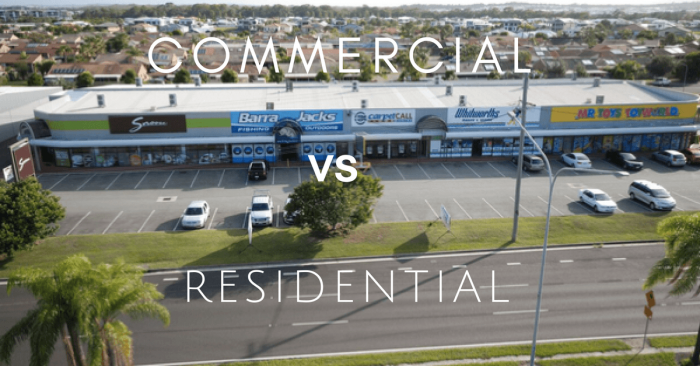5 ways commercial property and residential property investment differ
Published
March 27, 2018
Published
March 27, 2018

When thinking about how commercial property and residential property investment differ, most investors believe residential property is the much more simple option.
And this is why people are most likely to consider residential over commercial real estate investment.
There is also familiarity among home owners who have experienced the emotional turbulence of finding, negotiating, and buying a house firsthand. There seems to be a level of comfort with this common and widely understood transaction. The residential property market is also slightly more forgiving in price point and locality.
However, many first-time investors and even wholesale investors are missing out on attractive investment opportunities found in the commercial property space. Commercial property can often provide a far more secure, sustained, and lucrative return than residential property thanks to some key differences in the way the two markets work.
Here are some of the ways in which residential and commercial property investment differ.
1. Length of lease
Among other factors, commercial property derives its value from the length of its lease, which are generally far longer than those attached to residential property.
While one or two-year leases may be considered a comfortable term in residential investing, commercial property will see lease tenures of up to five, seven, ten, or even fifteen years.
Naturally, the lease secures the rental income for the landlord. So a fifteen-year commercial lease (to a reputable tenant) is a far more secure asset than even a one-year lease to an affluent family in a residential property.
2. Quality of tenant
The value of commercial property is also linked to the quality of tenant.
Perth-based hardware retailer Bunnings, for example, is a highly desirable tenant. They’re a large national brand with over 100 years historical performance, backed by the very profitable conglomerate Wesfarmers. These characteristics bring an enormous level of surety to the underpinning of the property and, due to the size of their outlets, such a tenant requires a long lease term.
Tenants with such appealing traits will naturally contribute to a higher purchase price when it comes time to sell. This is very distinct from the residential property market, where a simple tenant on a one-year lease will rarely affect the purchase price.
3. Return on investment
Once tenanted, most would be pleased with a 4 per cent annual return on their residential investment property. This is why negative gearing is so popular. A property may be rented at 4 per cent p.a. with interest payments of 4.5 per cent p.a. paid to the bank, which is considered a tax deduction. Ultimately, however, this represents a negative cash flow position.
With commercial property, an investor is likely to expect annual yields in the range of 7-10 per cent (depending on size, tenant, and location), resulting in net annual returns of 3-5 per cent once interest payments have been made.
Want to calculate negative gearing? Use our free Negative Gearing Calculator.
4. Payment of property outgoings
When investing in residential property your outgoings as landlord are seemingly endless, and almost always increasing. Council and water rates, repairs and maintenance, insurance, and property management fees are all recurrent expenses. These outlays can quickly begin to eat into your bottom line.
In contrast, landlords of a commercial property investment often structure a net lease. This is where the tenant will reimburse the landlord for property outgoings, such as rates & taxes and variable costs (electricity, lighting, security, etc.). Not only does this make for a more hassle-free investment, but a net lease avoids the erosion in income from these regular payments and costs.
5. Access to opportunities
Another major difference between residential and commercial property investment in Australia is the difficulty and complexity involved in acquiring commercial assets.
Obviously, commercial real estate investment is generally more expensive than its residential alternative. Many investors can find $250,000 to buy a residential unit, however, finding $15 million can be a little trickier. The process of acquiring such assets also involves a great level of sophistication as it can be far less forgiving than investing in residential property.
In addition, many of the most promising commercial property investments are unlisted. Even if such assets were advertised, they would cost a first-time or small-sized investor significant time, money, and resources to ensure the investment is worthwhile.
This does not mean ordinary investors are locked out of commercial property investment in Australia. It does mean, however, they must be astute and well prepared when deciding to take their first steps. A smart way to ensure this is investing through a commercial property syndicate or unlisted property trust.
If you’d like to know more about investing alongside experienced commercial property investors, get in contact with the team at Properties & Pathways.






